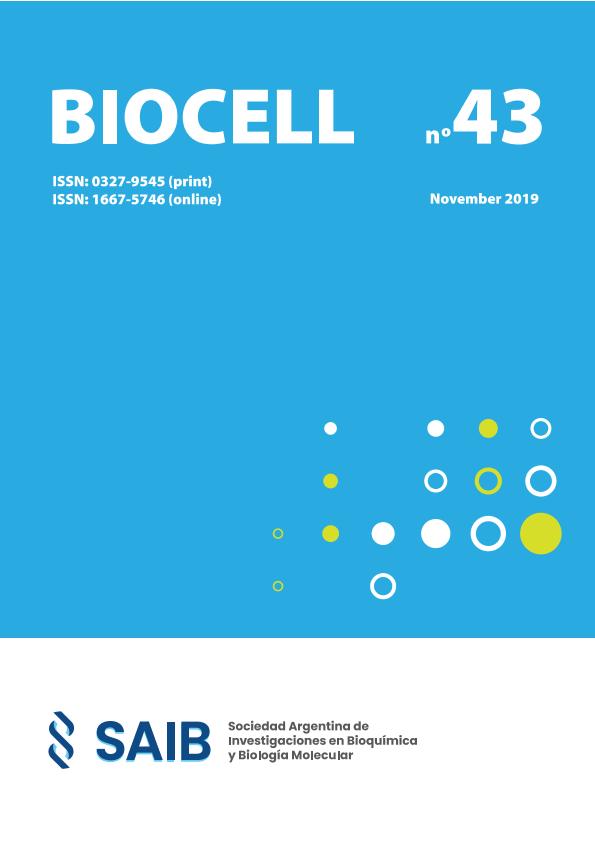Mostrar el registro sencillo del ítem
dc.contributor.author
Fabiani, Camila

dc.contributor.author
Biscussi, Brunella

dc.contributor.author
Munafó, Juan Pablo

dc.contributor.author
Salvador, Gabriela Alejandra

dc.contributor.author
Corradi, Jeremias

dc.contributor.author
Murray, Ana Paula

dc.contributor.author
Antollini, Silvia Susana

dc.date.available
2023-03-08T17:14:59Z
dc.date.issued
2019
dc.identifier.citation
Novel caffeine analogs as potential leaders on the cholinergic system; Congreso de la Sociedad Argentina de Investigación Bioquímica; Salta; Argentina; 2019; 78-79
dc.identifier.issn
0327-9545
dc.identifier.uri
http://hdl.handle.net/11336/189946
dc.description.abstract
Cholinergic deficit is regarded as an important factor responsible for Alzheimer’s disease symptoms. Two molecular targets for the treatment of this disease are acetylcholinesterase (AChE) and nicotinic receptor (nAChR). We previously demonstrated that caffeine has a dual effect on muscle and a7 nAChRs, behaving as a weak agonist at low concentrations and as a negative modulator at high concentrations. Furthermore, it is wellknown that caffeine also acts as an inhibitor of AChE. The aim of this work was to synthesize more potent caffeine analogs with a dual effect on the cholinergic system by inhibiting AChE and potentiating nAChRs. With this objective, a theophylline fragment, resembling the caffeine chemical structure, was connected with a pyrrole fragment, which is present in the nicotinic chemical structure, through homologation from 3 to 6 carbon atoms (Cn). We first tested the capacity of the different compounds to inhibit the AChE. We found that whether theophylline alone inhibited the enzyme, pyrrolidine did not. With respect to Cn, they all can inhibit the AChE at concentrations of 100, 200, and 400 µM, having C6 the strongest effect. We then explored if theophylline, pyrrolidine, and Cn influence the nAChR conformational state. To this end, we used the AChR conformational-sensitive fluorescence probe crystal violet (CrV) and AChR-rich membranes from Torpedo californica. We found that whether pyrrolidine induced changes in the KD values of CrV taking the nAChR to a state close to the desensitized one at concentrations of 200 and 400 µM, theophylline did not show a significant change in the KD value. The combined analogs also produced changes in the KD values of CrV. This effect was dependent on the length of homologation, being C5 and C6 the most potent analogs with effect at concentrations lower than 50 nM. To understand the molecular mechanism underlying the conformational changes of the nAChR, we expressed adult muscle nAChR in HEK293 cells and performed single-channel recordings with different Cn concentrations. We found that C5 activated muscle nAChR at very low concentrations (from 0.01 pM). At the highest tested concentration (30 µM), we observed a decrease in the mean open duration, which suggests that C5 also acts as an open channel blocker. As a partial conclusion, we can say that we have synthesized more potent caffeine analogs through the combination of caffeine and nicotinic structures. The effect of theophylline on AChE, the effect of pyrrole on AChR, and the effect of Cn on both proteins suggest different pharmacophore profiles for these target molecules. Our results bring new information about the mechanism of modulation of pharmacologic targets for the design of new therapies for the intervention in neurological diseases.
dc.format
application/pdf
dc.language.iso
eng
dc.publisher
Sociedad Argentina de Investigación en Bioquímica y Biología Molecular
dc.rights
info:eu-repo/semantics/openAccess
dc.rights.uri
https://creativecommons.org/licenses/by-nc-sa/2.5/ar/
dc.subject
nicotinic acetylcholine receptor
dc.subject
alzheimer
dc.subject
caffeine analogs
dc.subject
acetylcholinesterase
dc.subject.classification
Biofísica

dc.subject.classification
Ciencias Biológicas

dc.subject.classification
CIENCIAS NATURALES Y EXACTAS

dc.title
Novel caffeine analogs as potential leaders on the cholinergic system
dc.type
info:eu-repo/semantics/publishedVersion
dc.type
info:eu-repo/semantics/conferenceObject
dc.type
info:ar-repo/semantics/documento de conferencia
dc.date.updated
2023-02-16T10:23:19Z
dc.identifier.eissn
1669-9106
dc.journal.volume
43
dc.journal.number
Suplemento V
dc.journal.pagination
78-79
dc.journal.pais
Argentina

dc.journal.ciudad
Mendoza
dc.description.fil
Fil: Fabiani, Camila. Consejo Nacional de Investigaciones Científicas y Técnicas. Centro Científico Tecnológico Conicet - Bahía Blanca. Instituto de Investigaciones Bioquímicas de Bahía Blanca. Universidad Nacional del Sur. Instituto de Investigaciones Bioquímicas de Bahía Blanca; Argentina. Universidad Nacional del Sur. Departamento de Biología, Bioquímica y Farmacia; Argentina
dc.description.fil
Fil: Biscussi, Brunella. Consejo Nacional de Investigaciones Científicas y Técnicas. Centro Científico Tecnológico Conicet - Bahía Blanca. Instituto de Química del Sur. Universidad Nacional del Sur. Departamento de Química. Instituto de Química del Sur; Argentina
dc.description.fil
Fil: Munafó, Juan Pablo. Consejo Nacional de Investigaciones Científicas y Técnicas. Centro Científico Tecnológico Conicet - Bahía Blanca. Instituto de Investigaciones Bioquímicas de Bahía Blanca. Universidad Nacional del Sur. Instituto de Investigaciones Bioquímicas de Bahía Blanca; Argentina. Universidad Nacional del Sur. Departamento de Biología, Bioquímica y Farmacia; Argentina
dc.description.fil
Fil: Salvador, Gabriela Alejandra. Consejo Nacional de Investigaciones Científicas y Técnicas. Centro Científico Tecnológico Conicet - Bahía Blanca. Instituto de Investigaciones Bioquímicas de Bahía Blanca. Universidad Nacional del Sur. Instituto de Investigaciones Bioquímicas de Bahía Blanca; Argentina. Universidad Nacional del Sur. Departamento de Biología, Bioquímica y Farmacia; Argentina
dc.description.fil
Fil: Corradi, Jeremias. Consejo Nacional de Investigaciones Científicas y Técnicas. Centro Científico Tecnológico Conicet - Bahía Blanca. Instituto de Investigaciones Bioquímicas de Bahía Blanca. Universidad Nacional del Sur. Instituto de Investigaciones Bioquímicas de Bahía Blanca; Argentina. Universidad Nacional del Sur. Departamento de Biología, Bioquímica y Farmacia; Argentina
dc.description.fil
Fil: Murray, Ana Paula. Consejo Nacional de Investigaciones Científicas y Técnicas. Centro Científico Tecnológico Conicet - Bahía Blanca. Instituto de Química del Sur. Universidad Nacional del Sur. Departamento de Química. Instituto de Química del Sur; Argentina
dc.description.fil
Fil: Antollini, Silvia Susana. Consejo Nacional de Investigaciones Científicas y Técnicas. Centro Científico Tecnológico Conicet - Bahía Blanca. Instituto de Investigaciones Bioquímicas de Bahía Blanca. Universidad Nacional del Sur. Instituto de Investigaciones Bioquímicas de Bahía Blanca; Argentina. Universidad Nacional del Sur. Departamento de Biología, Bioquímica y Farmacia; Argentina
dc.relation.alternativeid
info:eu-repo/semantics/altIdentifier/url/https://newsite.saib.org.ar/publicaciones/
dc.relation.alternativeid
info:eu-repo/semantics/altIdentifier/url/https://saib.org.ar/archivos/biocell-43.pdf
dc.conicet.rol
Autor

dc.conicet.rol
Autor

dc.conicet.rol
Autor

dc.conicet.rol
Autor

dc.conicet.rol
Autor

dc.conicet.rol
Autor

dc.conicet.rol
Autor

dc.coverage
Internacional
dc.type.subtype
Congreso
dc.description.nombreEvento
Congreso de la Sociedad Argentina de Investigación Bioquímica
dc.date.evento
2019-11-05
dc.description.ciudadEvento
Salta
dc.description.paisEvento
Argentina

dc.type.publicacion
Journal
dc.description.institucionOrganizadora
Sociedad Argentina de Investigación en Bioquímica y Biología Molecular
dc.description.institucionOrganizadora
Panamerican Association for Biochemistry and Molecular Biology
dc.source.revista
Biocell

dc.date.eventoHasta
2019-11-08
dc.type
Congreso
Archivos asociados
